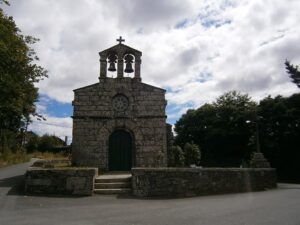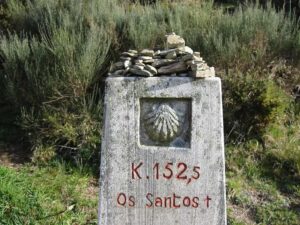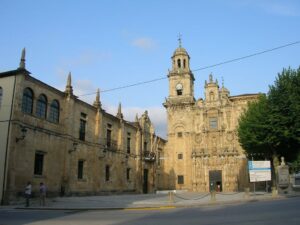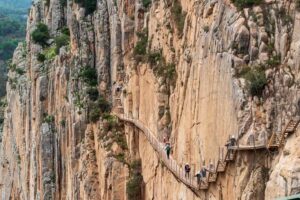
The Camino de Santiago is full of impressive and beautiful places to discover, such as Ribadeo. This charming town is located in the province of Lugo, almost on the border with Asturias.
If you pass through during your pilgrimage with one of the Camino de Santiago travel companies, Ribadeo has various attractions that will captivate you from the first moment. It has a seafaring charm and an indiano past that you can still see in many of its buildings.
Although it is not part of the French Way, you will find that it combines several elements with those of the Northern Way. As explained on a trip along the French Way from Sarria, these are its main points of interest.
Índice de contenidos
Plaza de España

For the inhabitants of this town, this is one of the most important places, as practically all the streets in the centre lead to Plaza de España.
Also known as Plaza de O Campo, it is a beautiful completely landscaped space. It is surrounded by some of the oldest and best-preserved buildings in Ribadeo, such as the Torre de los Moreno, the Convento de Santa Clara, and the Pazo de los Ibáñez.
Torre de los Moreno
Continuing our visit to Plaza de España, right here is the Torre de los Moreno. It is the first indiano building in all of Ribadeo, though it is not the only one. It was built by two emigrant brothers around 1915, in a completely eclectic indiano style, though it also has some Catalan modernist influences.
At the time of its construction, it became the most modern building on the Northern Way. It is especially striking for its beautiful facade that perfectly combines with the roof, very typical of Central Europe.
Both the Torre de los Moreno and the centre of Ribadeo were declared Sites of Cultural Interest.
Pazo de Ibáñez
The Pazo de Ibáñez was commissioned by the Marqués de Sargadelos, Raimundo Ibáñez. It is a building in neoclassical style, which served as the nobleman’s residence.
In fact, Ibáñez was the great promoter of the town’s commercial port, as well as the industrialization process of the area, being the founder of the Royal Sargadelos Ceramic Factory. Currently, the Pazo houses the Ribadeo Town Hall, with a statue of the Marqués at the entrance.
Ribadeo Port

Its real name is Puerto de Porcillán, although everyone knows it as Ribadeo port. Additionally, it is the heart of this beautiful town, which has maintained maritime commercial activity for centuries.
Between the 16th and 17th centuries, the town thrived on the transport of wine, salt, iron, and wood. By the 18th century, it reached its peak by opening its connections to the Baltic Sea, where linen, hemp, and spirits were traded.
Today, the port is used solely for recreational purposes, though it is undoubtedly a must-see if you are walking the Northern Way.
Casa do Patín
Located on Muralla Street, named so because here you can see a section of the old medieval wall that still stands in Ribadeo. The Casa do Patín is the oldest civil building in the town.
Although there is no exact date for its construction, its facade is the only element that remains unaltered. It is covered in vegetation, so from the first moment, you will feel charmed to be here.
You will also see the coat of arms of the Menéndez-Navia and Villamil family, important merchants who were involved in the timber trade. As a final detail, you should know that the house shares its inner courtyard with the Municipal Library.
Barrio de San Roque
For some, this is the quintessential indiano area of Ribadeo. Around 1870, the first indianos began to return and settled in this place, which at the time was part of the town’s outskirts.
It stands out for its colourful and landscaped facades, built under the architectural influence of American cities like Buenos Aires or Havana.
Since 2014, during the first weekend of July, the Ribadeo Indiano Festival is held here. It serves to remember those first Galicians who went to the Americas and returned with large amounts of money.
Both locals and tourists dress in period clothing, with lots of music and traditional cuisine. It is undoubtedly one of the most striking celebrations on the Northern Way.
La Atalaya de Ribadeo
Just as on the Camino de Santiago through Tui, being a town where slopes are prominent, in Ribadeo you have the advantage of finding many viewpoints with breathtaking views. The clearest example is La Atalaya.
For centuries, this place has served to guide the navigators of the estuary with torches. In fact, in the 16th century, a defensive bulwark was built here, of which a few cannons still remain.
To get here you can take the panoramic elevator and enjoy the views of the Puente de los Santos, the estuary, or the Puerto de Porcillán.
While Ribadeo stands out with its unique charm on the Northern Way, it is impossible not to think of the richness that characterises other pilgrimage routes, such as the stages of the Portuguese Way.
Playa de las Catedrales
Playa de las Catedrales, officially known as Praia de Augas Santas, is one of the most iconic and spectacular places in Ribadeo. This natural monument, located about 10 kilometres away, is famous for its impressive rock formations that resemble the arches and columns of a Gothic cathedral.
These formations are the result of wind and water erosion over thousands of years. During low tide, it is possible to walk among these arches and natural passageways, exploring caves and nooks hidden at the base of the cliffs. These structures can reach up to 30 metres in height, creating a unique visual spectacle.
Each path to Santiago de Compostela offers a unique palette of landscapes, stories, and traditions, reflecting the cultural and natural diversity of the Iberian Peninsula. Just as Ribadeo captures the essence of seafaring spirit and indiano legacy, the Portuguese stages of the Camino embrace the beauty of their surroundings, from serene coasts to vibrant green fields.









